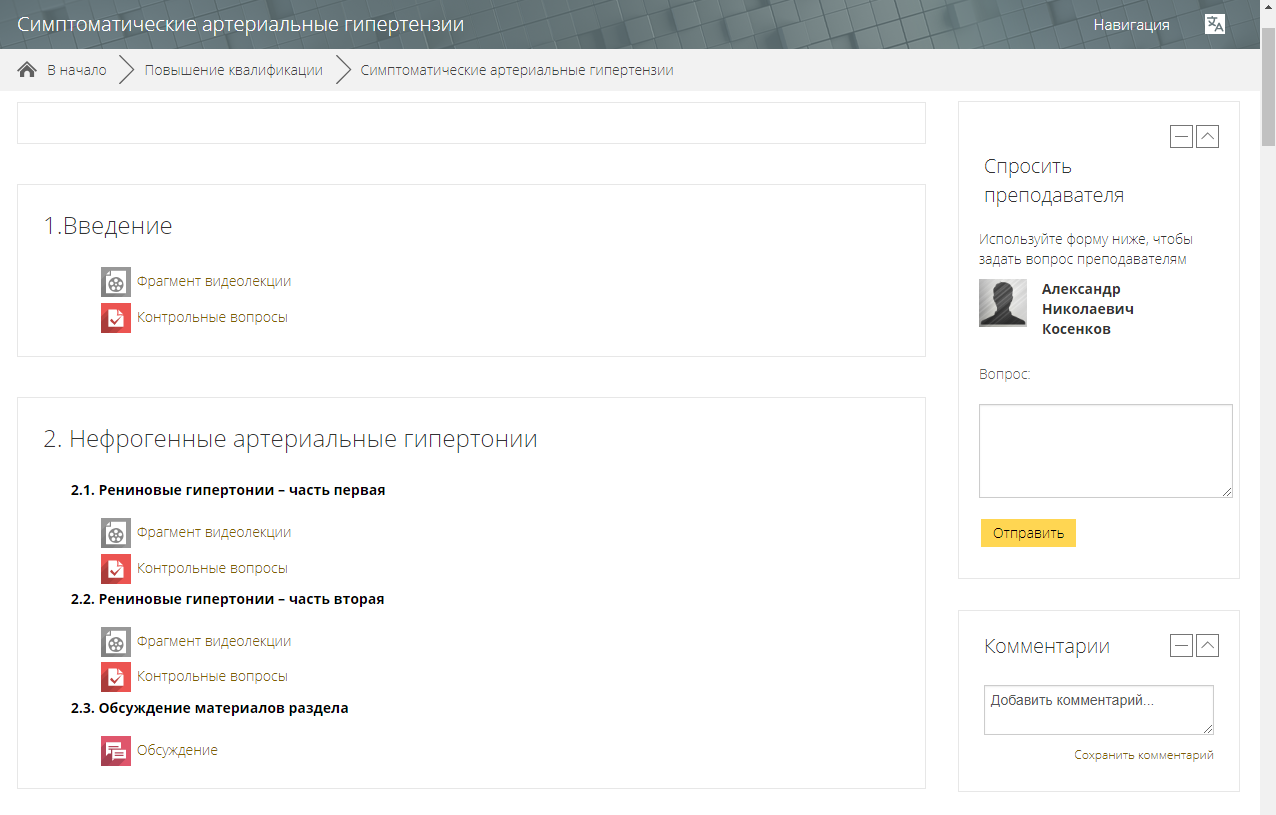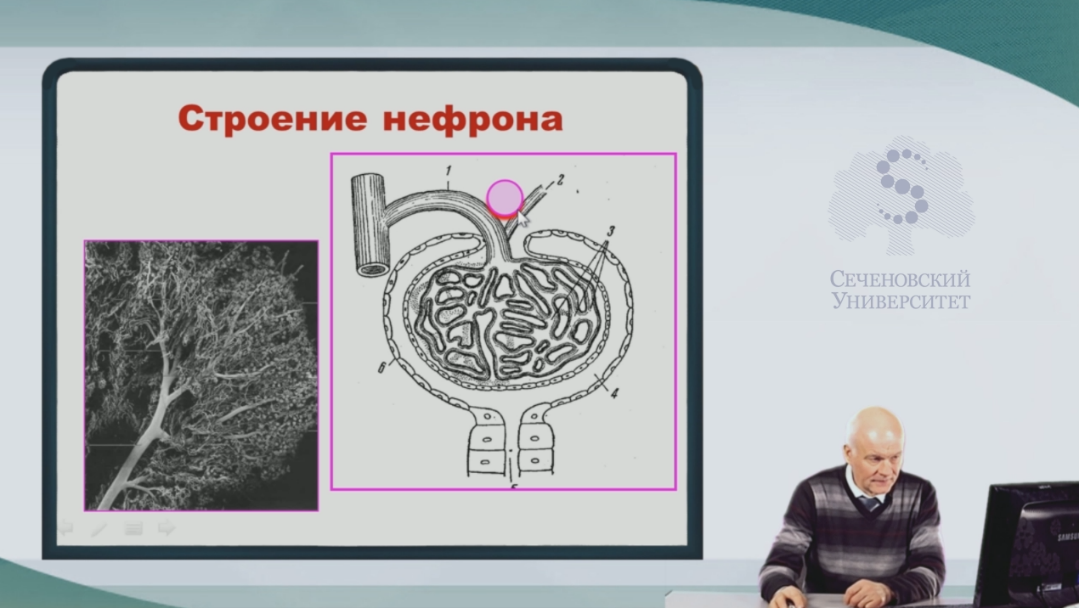Abstract
The paper describes the results of development and implementation of physicians’ professional communication service. In contrast to social networks, the communication with the use of this service will be strictly regulated and exercised under centralized control. It means, that user authorization is needed, professional topics will be discussed, users’ actions analyze will be carried out. The topic content management will be carried out by its leader. The leader is a specialist with a high professional authority. Most often it is the professor of the head department or the scientific center. The topic choice for discussion will be done collectively by communication participants. Professional communication topic are isolated from each other. At first, the potential users have an opportunity to study theory with the help of watching video-lecture and their fragments or reading. Users studied the theory would be allowed to complete testing for the topic sections at first and then for the whole topic. After successful completion of testing users can take part in communication with other users and the leader of topic. They can ask questions, share their experience and best practices, including multimedia usage. In the future, the service can be used for professional medical specialists’ accreditation process that is used in different countries. In Russian, it can supplement mandatory state accreditation.
Keywords: Developmentprofessional communication servicephysiciansregimentationcentralized controlMoodle
Introduction
At present, there is no physicians’ professional communication service that would be developed with the help of modern information, social, educational and organizational technologies and able to work with the large number of users across the country. Several attempts have been made to use social networks, but it has not been successful. There are many reasons for it. The main reason is that social networks is unsuitable for effective professional communication. The internal organization of social networks provides that every network user is free to choose communication topics (Salehan et al., 2017). It means that there is no clear regulation or control of topics (Yu et al., 2016; Rehm et al., 2016).
It fundamentally contradicts the tasks of creating a professional communication service aimed at professional and career development of physicians in accordance with standards of their professional activities (Sprenger et al., 2015) .
Therefore, Moodle was chosen as basic software for service development. On one hand, Moodle is used for the centralized management of digital learning and it presupposes process regulation, corresponding to university standards. On other hand, Moodle has high level of functional flexibility and additional capabilities. It allowed creating a professional communication service.
In the process of the service developing many private technological solutions were used. In particular, for video lectures creation, surgeries recording etc. (Alkhathlan & Al-Daraiseh, 2017; Brownson, 2014).
Problem Statement
Communication between physicians of different specialties on a wide range of topics across the country is a task not only for the medical community, but also for the sociality.
Currently, there is a reduction in the cost of the existing government support system of the physicians’ maintaining and upgrading. As a result, the professional level of medical workers is decreasing. It means that the single space of medical knowledge and competences is destroyed nationwide. This problem requires resolving with the help of both the medical community and the community of patients. Described service can be one of the tools for resolving this urgent issue (Mettler, 2018).
Therefore, we set ourselves following goals: development of the tool that makes possible increasing the professional level of medical personnel throughout the country, new skills and physicians’ career growth promotion (Nikulchev et al., 2017).
These goals were transferred to the solution of specific issues, carrying out specific studies and integrating the results.
The paper describes common idea of this tool and the first steps of development.
Research Questions
Service development and launch of the introduction needed to complete a number of theoretical and practical questions:
In particular, how should the service use strictly regulated technologies of learning process organization, implemented in Learning Management System program, on one hand, and possibility of unlimited communication in social networks, on other hand?
Should physicians’ professional communication be regulated and managed, what should be the degree of this regulation?
Which informational, educational, sociological, organizational and legal technological solutions could be used for professional communication service development?
Certainly, such global issues will be revised in development and implementation process. However, in the first developing iteration they were resolved.
Purpose of the Study
The authors aimed to select based on theoretical studies and practical tests concrete solutions, able for professional communication service development and for integration these parts into effectively functioning software.
Research Methods
To achieve the objectives and to answer the questions raised, following methods were used:
questioning of physicians of different specialties (815 physicians) on the need and prospects of professional communication services in competence enhancing, career development and their participation in this service;
questioning of physicians of different specialties (342 physicians) on the proper proportion of communication regulation in the professional communication process;
theoretical research and enhancing the experience of the participation in a number of foreign and domestic social networks for common use;
theoretical research and enhancing the experience of the participation in social networks for professional use, including the most popular LinkedIn и Gate Research;
exploring the possibilities of the most common foreign and domestic software for digital learning management – Learning Management System (LMS);
choosing the optimal software and studying its basic and additional capabilities;
choosing of software and technologies for mass production of video content required for professional communication service (e.g., video lectures, their fragments, video recording of medical manipulations and surgical operations);
formulating the hosting requirements for service of physicians’ professional communication.
Methodical work was carried out based on the Department of Hospital Surgery at Sechenov First Moscow State Medical University. Service finalization and initial introduction are carried out with the help of the students of the department.
Findings
Currently, the basic implementation principles of professional communication service are developed. Communication in the service are regulated and implemented under centralized control. The issue of themes creating and professional communication level setting was resolved. The accounting, analyses and generalization of users’ actions are carried out. Verified user authorization is being worked out.
Management and moderation of every communication topic is carried out by its leader. The leader is one of the professors on the Department of Hospital Surgery at Sechenov First Moscow State Medical University. The topics choice is currently being carried out by the same Department.
The topics are isolated from each other according to the theme. At first, the potential users have an opportunity to study theory with the help of watching video-lecture and their fragments or reading. Users successfully studied the theory are allowed to complete testing. This testing is divided into two parts: question sets for every sections of the topic and question set for the whole topic. After successful completion of testing users can take part in communication with other users and the leader of topic. They can ask questions, share their experience and best practices, including with the use of multimedia. The general sequence of study and discussion is given on the example of the topic “Review from the surgical positions of symptomatic arterial hypertension” (Table
Service processes are implemented in Moodle, LMS open source software. Therefore, its functional flexibility and additional features were used (Fig.


Conclusion
It is necessary to note that during the development it became possible to move beyond the common use of Moodle software and to implement fully-fledged service for physicians’ professional communication.
The material for service was collected with the help of well-organized and delivered video production (video lectures, their fragments, video records of surgical operations etc.).
In our view, professional communication implemented in such form can be an effective tool for professional and career development of medical specialists, increasing their level of competence and enhancing their skills.
In the future, the service can be used for professional medical specialists’ accreditation process that is used in different countries.
References
- Alkhathlan, A. A., & Al-Daraiseh, A. A. (2017). An Analytical Study of the Use of Social Networks for Collaborative Learning in Higher Education. International Journal of Modern Education and Computer Science, 9(2), 1.
- Brownson, S. (2014). Embedding Social Media Tools in Online Learning Courses. Journal of Research in Innovative Teaching, 7(1). 112-118
- Mettler, T. (2018). Contextualizing a professional social network for health care: Experiences from an action design research study. Information Systems Journal, 28(4), 684-707.
- Nikulchev, E., Ilin, D., Bubnov, G., Osipov, I., & Kosenkov, A. (2017). Modernization Of Educational Programs Of Professional Skill Improvement Using Patent Activity Data. The European Proceedings of Social & Behavioural Sciences EPSBS, 33, 272-281.
- Rehm, S. V., Goel, L., & Junglas, I. (2016). Information management for innovation networks—an empirical study on the “who, what and how” in networked innovation. International Journal of Information Management, 36(3), 348-359.
- Salehan, M., Kim, D. J., & Kim, C. (2017). Use of online social networking services from a theoretical perspective of the motivation-participation-performance framework. Journal of the Association for Information Systems, 18(2), 141.
- Sprenger, M., Blondiau, A., Rohner, P., & Mettler, T. (2015). Benefits of Professional Social Networks: Expectations and Design Implications for the Healthcare Domain. In Proceedings of the 17th International Symposium on Health Information Management Research – ISHIMR 2015. Retrieved from https://www.alexandria.unisg.ch/241955/1/ATTCFPVC.pdf
- Yu, S., Christakopoulou, E., & Gupta, A. (2016, August). Identifying decision makers from professional social networks. In Proceedings of the 22nd ACM SIGKDD International Conference on Knowledge Discovery and Data Mining (pp. 333-342). ACM.
Copyright information

This work is licensed under a Creative Commons Attribution-NonCommercial-NoDerivatives 4.0 International License.
About this article
Publication Date
23 November 2018
Article Doi
eBook ISBN
978-1-80296-048-8
Publisher
Future Academy
Volume
49
Print ISBN (optional)
-
Edition Number
1st Edition
Pages
1-840
Subjects
Educational psychology, child psychology, developmental psychology, cognitive psychology
Cite this article as:
Kosenkov, A. N., Labutskiy, A. K., & Telegin, Y. N. (2018). Service For Professional Communications Of Physicians. In S. Malykh, & E. Nikulchev (Eds.), Psychology and Education - ICPE 2018, vol 49. European Proceedings of Social and Behavioural Sciences (pp. 288-293). Future Academy. https://doi.org/10.15405/epsbs.2018.11.02.32

